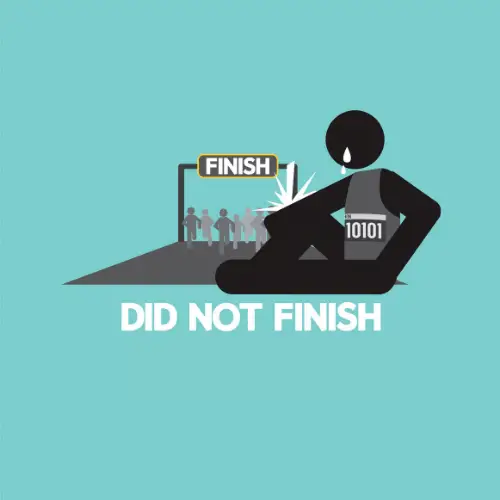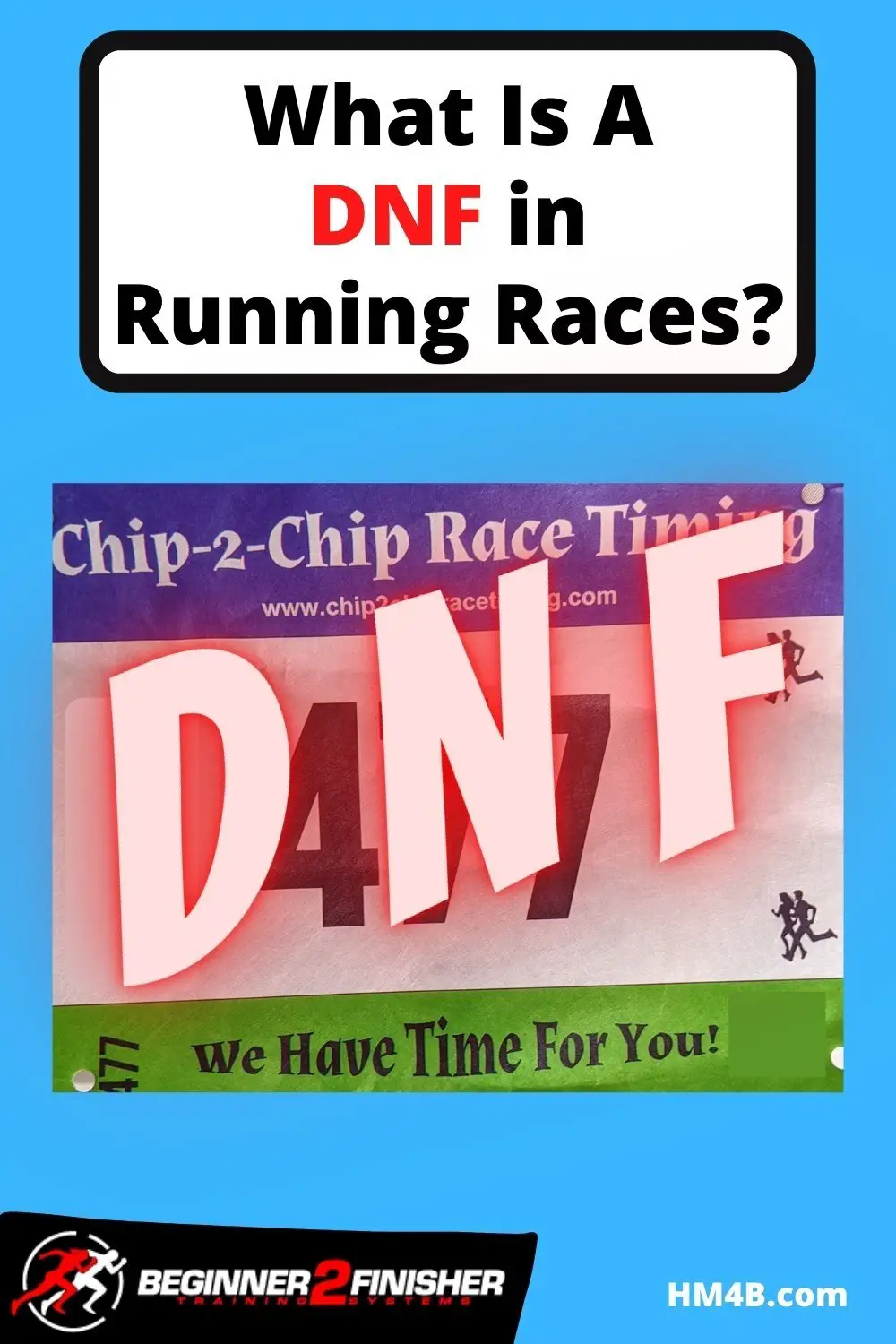All types of racing feature use of common acronyms to explain how contestants fare in a particular contest – from the well-known first, second and third place, on down the line, to those who just did not make it to the finish line. Most racers and fans are familiar with DSQ (or DQ), for disqualified. What about other designations?
For instance, what is a DNF in racing? Research reveals that seeing “DNF” next to the name of a race contestant, race team or racehorse means “did not finish,” usually on any grounds as cited by the participant. Depending on the size of a race there is a list of DNFs, for a great variety of reasons. Some events list a number of DNFs well into the hundreds, such as for large marathons.
It’s not as easy as just quitting, though. A DNF can happen at any moment for any reason, and carry psychological implications down the road for some. Not all DNFs are voluntary, but many are.
What Qualifies for a DNF Denotation?
Depending on the sport, contestants can be designated DNF at the end of a race for any number of reasons including but not limited to:
- Accidents
- Injury
- Illness
- Inclement Weather
- Mental
The term is pretty much universal to all forms of racing including auto racing, motorcycle racing, cycling, track, skiing, and running for distance. The most common DNFs occur in these stamina-demanding track and field-related events like marathons, triathlons, or the decathlon.
Was the weather too cold? For a detailed post of the dos and don’ts of running in cold weather, check out:
How To Run In Cold Weather – Beginner’s Guide
A look at DNF reasons across the racing spectrum:
Accidents
Accidents are a primary reason for a DNF denotation. In racing sports where participants run at full speed while crowded together, often along curves or winding roads, mishaps happen.
Notable DNFs include:
- Mary Decker at the 1984 Olympics, where she was heavily favored to win the gold medal in the 3000 meters run, yet failed when her feet got tangled up with nearby runner Zola Budd, and tumbled to the track. Decker injured her hip in the spill to end her Olympic hopes.
- Sadly, DNF is the officially recorded finish for NASCAR legend Dale Earnhart’s final race, when he died in a head-on crash into a race track retaining wall.
- Perhaps the most-famous DNF was not a race, per se, but from a ski jump competition. Slovenian ski jumper Vinko Bogataj was made forever famous when ABC-TV’s “Wild World of Sports” each week showed a Bogatej’s horrendous wipeout off a snow ski jump – to represent “The Agony of Defeat.” Amazingly, the ski jumper only suffered a broken ankle and mild concussion.
Injury
- Pulled hamstrings or various leg injuries often are the culprit for a DNF in running races; though some contestants earn fame or commendations for limping to finish lines and avoiding the designation. Some runners even have been carried to the finish line by other contestants, in a show of camaraderie and sportsmanship.
- Dehydration is responsible for DNFs in nearly all racing sports.
- Sometimes a DNF by a racehorse is difficult to ascertain; since they cannot communicate, if an injury is not clearly evident, trainers are left to wonder whether it could be an upset stomach, soft-tissue pain, or just no desire to race that day. Yes, equines have attitudes, too.
Illness
- Not race-related, but a DNF nonetheless: in boxing, many remember Roberto Duran quitting the “No mas” match with Sugar Ray Leonard mid-round, claiming an upset stomach to stop the fight. (Some believed Duran was losing and felt comfortable with his take of the prize money whether he lost or not).
Equipment Failure
- Blisters caused by new or poor running shoes end many a race for some contestants.
- Touring bicyclists also have been known to drop out of races when a bike component fails or just does not perform to the biker’s expectations.
Inclement Weather
- Some race DNFs are influenced by inclement weather, such as hard rains or snowfall, winds, and even heat. Specific racers just might feel that day’s temperature or weather conditions are not conducive to competing.
- Winds can tend to scare race competitors already nursing an injury, or otherwise impaired enough to impact their ability to race. It would seem this might be especially true in long-distance bicycle racing, where balance at high speeds is imperative.
- This does not consider races entirely postponed or canceled due to the weather. It implies the race in question was completed, but certain participants chose to quit rather than braving it.
Mental
Mental or personal reasons to not finish a race are plentiful throughout racing history:
- Ultramarathon walkers have been known to blame “Not Having Fun Anymore” for a DNF.
- Some contestants have dropped out after hearing bad news during a race, such as the death of a family member or loved one, adding emotional reasons for quitting.
- Making the decision to quit mid-race can be extremely difficult for racers already with their competitive juices flowing. How often do we see runners or even horses so far behind that they are lapped by leaders – yet they keep running, thinking only of the finish line.
Are There Penalties or Stigmas for DNFs?
Additionally, too many DNFs in any racing sport can place a stigma on a runner. Fans are not fond of contestants constantly not finishing, or not starting at all, due to various injuries or illnesses.
What is ‘Death Before DNF’?
Many top-level triathletes adhere to the “Death Before DNF” slogan, meaning just what the statement implies. The slogan has been criticized by some in the sport and in the medical field, who question how healthy it is for participants to push ahead while suffering from serious ailments such as dehydration.
Insight can be gathered via an article by French triathlete and snowboarder Veronique Vallieres, who concluded that some contestants successfully attain DNF – but it means Did Not Fail. Pushing a body to its limits to avoid quitting and failing can teach athletes to push their bodily limits and help strengthen the body and mind for contests that follow.
Why is running so hard for new runners?
How many runners at big marathon races are DNFed?
The DNF designation in racing has been the subject of many studies over the years, producing statistics and psychological observations by scholars and fans alike, from around the world.
For instance, did you know there can be over 500 DNFs in any given New York Marathon? Though that still represents only about 1% of participants, it indicates the sheer size of the race in terms of the number of runners.
Athletes are competitive by nature, and most racers wish to avoid the perception, reputation, and negative stigma that can be attached to a DNF. Said French marathoner Veronique Vallieres about the DNF, it “haunts us forever after a race, no matter the reason that forces an athlete to abandon a race before reaching the finish line.”
Much has been said about the psychological impact of not finishing a race once started. The New York Times made an analysis following the huge marathon in that city in 2009. Interestingly, the newspaper discovered that recreational runners fought to complete the race more than elite runners. Elite runners tend to be more prone to quit if they were not performing optimally or something was not quite right.
The same was true for runners who traveled far to run the race: they fought to endure and see the finish line.
Related: How To Pack Your Suitcase For a Destination Running Race!

Are There More DNFs in Some Sports Compared To Others?
Again, reasons for not finishing a race differ for a great number of reasons. One study found that in track and field, decathlon athletes showed a 22% DNF rate as a whole. It contrasts greatly with the less than 1% to 6% of individual track event contestants. One might assume it means decathletes either only wish to perform while at their peak, or they respect their bodies to drop out when the brain signals trouble.
The study concluded that DNFs in a decathlon are common and that some events that require detailed technical perfection or physically explosive moments like those involving jumping or hurdling are more prone to force quit.
Elite athletes also often plan for top performances at marquee contests. This means they might be inclined to run a half race or drop out if any sign of fatigue if a more-attractive event is upcoming. Some marathon racers, for insurance, might sign up for a race just for the training, with the 26.2 miles to finish less of an objective than maintaining their lungs and stamina.
How do runners mentally get past DNFs?
If a runner receives a DNF it’s not the end of the world. There are several strategies that can push a runner through a DNF.
Analyze what “really” happened
Ask yourself, “why did I have a bad race?” Did the weather play a part in your bad race? There are 5 questions I always ask myself after a bad race that can help you mentally reposition your DNF or horrible run. Check it out here: 5 questions to ask yourself after a bad run.
First, the runner needs to take a deep post-mortem look as to why they didn’t finish the race.
You have to forgive yourself and your DNF
Sometimes DNFs are a blessing in disguise. According to ultra-marathon runner, Candice Burt, “You’re really not a real ultra runner until you DNF.” Sometimes you’re better off dropping out of the race, taking your DNF, and saving your legs for another running day. Get past the shame and sign up for the next race.
Sign up for a new race soon after your DNF
To keep your mind from cascading into pools of emptiness, sorrow, and despair about your DNF. Research your next big race, figure out when you need to start training, and sign-up. You will be jolting your mind out of the wallows of despair and pushing it to another goal.
Talk to seasoned runners, your running coach, or a running club
Sometimes talking to someone else about your DNF can help you turn your frown upside down. Sometimes talking to a spouse is the first choice to release those built-up DNFs emotions. However, if your spouse isn’t a runner, they might not be able to give you back any critical advice. If this is the case turn to a running coach or someone that understands running and the pains involved. They might be able to boost your morale a lot quicker and shorten the hum-drum stages of a DNF.
For more information on how to shake your post-race blues check out:
How to shake off your post-race blues
Related Questions
Q.: What is DNS or DSQ in racing?
A.: DNS means Did Not Start, which might be better received than a DNF since the participant never was ready to compete. Many complaints about DNF are that quitters only walk away when losing, or they do it too often.
DSQ means disqualified. In many racing sports, it might be shortened to simply DQ. The latter is often used in racing terminology, as in, “He was DQ’d before the race.” You see this often in auto or motorcycle racing when pre-race inspections reveal violations to an engine or vehicle components.
Great insight into DNF and DNS can be gained by reading an article by marathoner Rhalou Allerhand in Runner’s World in 2015. The writer lamented about starting and finishing races with a cold, the mental anguish involved, with supplemental input from medical and fitness experts.
Many athletes are quite aware of the danger of long-term injury from pushing hard while hurting. In baseball, the careers of stars like Mickey Mantle and Kirk Gibson were said to be reduced in impact due to playing through injuries. Other athletes in a range of sports pushed so hard their careers ended prematurely.
The consensus among health-focused experts? Exercising while ill can damage one’s health. Yet, competing just for the sake of finishing, even without a chance to place well in the overall field of competitors, continues.
Q.: What might disqualify a racer from a contest?
A.: It depends on the sport. In October 2019, a 16-year-old was disqualified from a cross-country run in Ohio because she wore her hijab without permission.
Q.: Are there any other racing acronyms or terms known by insiders?
A.: Consider these: DFL for “Dead Freaking Last” and the best – DNFF – which stands for “Did Not F*****G Finish!” used by the absolutely pissed off, angered runners that quit before the end of a hard race.
References
https://www.runnersworld.com/uk/health/a774085/dns-or-dnf/
https://en.wikipedia.org/wiki/Did_Not_Finish
https://www.sciencedirect.com/science/article/abs/pii/S0765159710001607?via%3Dihub
https://slangit.com/meaning/dnf


